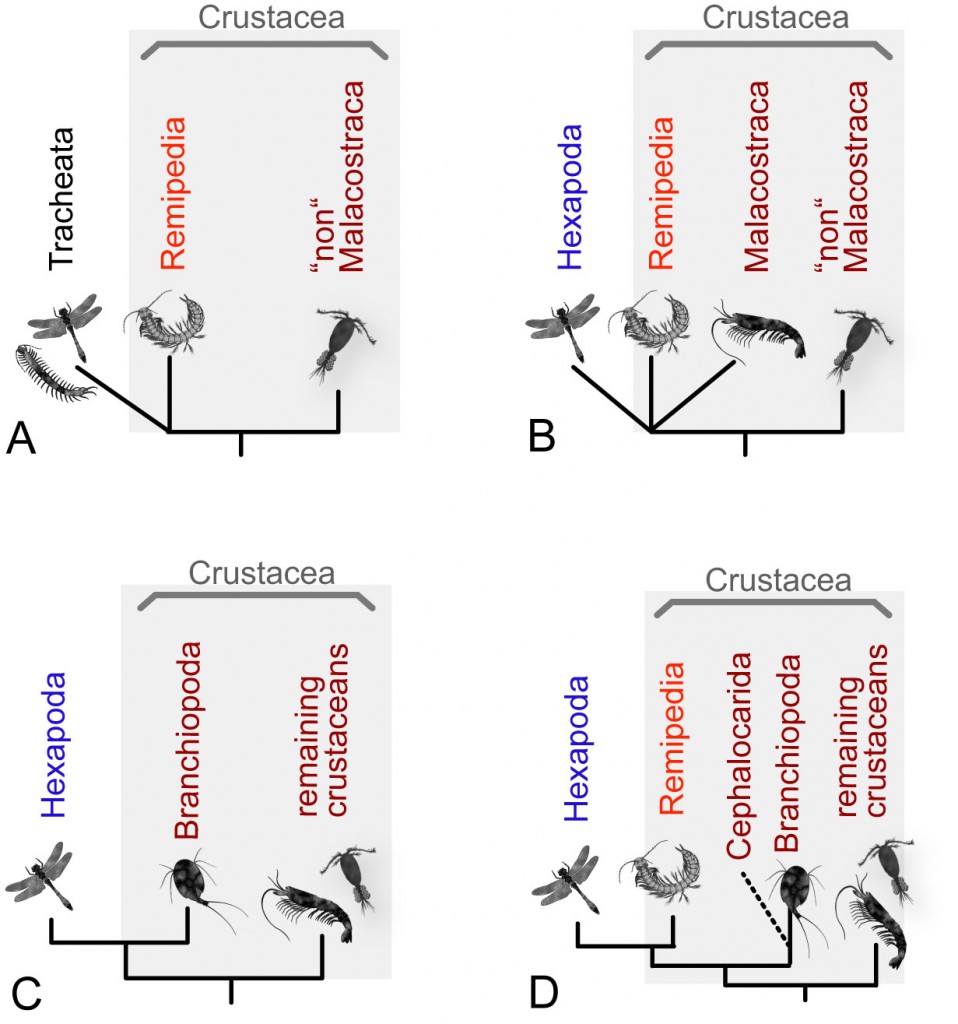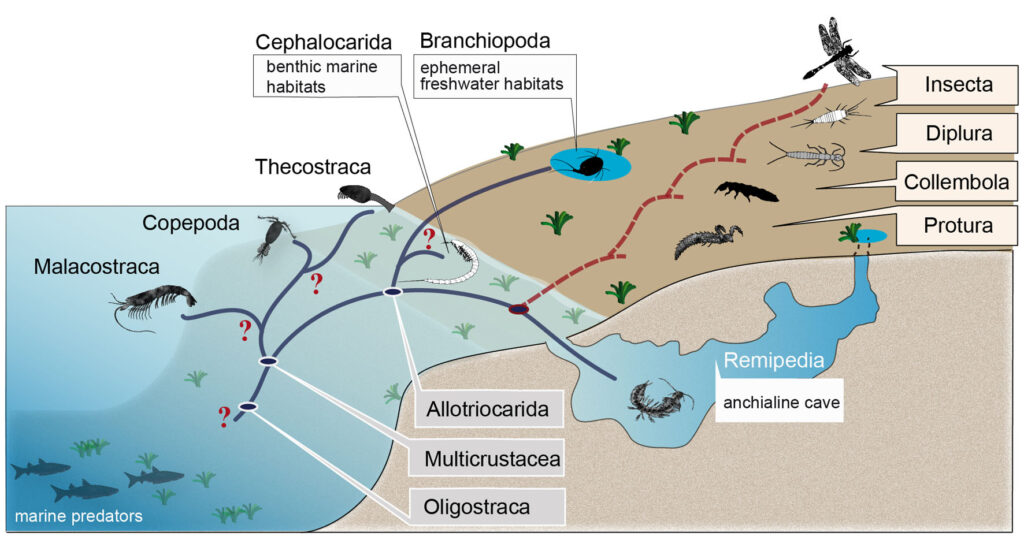Phylogenomics of pancrustaceans – present data and future perspective
 Past and recent analyses. After ambiguous results from single and multigene studies, phylogenomic data contributed some insights into crustacean evolution. In particular Remipedia as closest relatives to Hexapoda are highly supported. This result is also supported by older morphological data interpretation and recent evelopmental and neuroanatomical data. Yet, molecular analyses including phylogenomic data generally place Branchiopoda closer to Hexapoda, while selected morphological, neuroanatomical, and larvaldevelopment data suggest a closer relationship of Malacostraca to Remipedia and Hexapoda. A similar pattern is found for the Cephalocarida, their close relationship to Remipedia in molecular analyses is not supported by recent neuroanatomical data (Stegner & Richter 2011). Interestingly, a previous comprehensive rDNA study on euarthropods (von Reumont etal. 2009) reconstructed a SG relationship of Cephalocarida and Branchiopoda, which is recently supported by Oakley and colleagues in a combined transcriptomic analyses including morphological and molecular data (Oakley etal. 2013). Paleontological data e.g. (Walossek 1993) would support this scenario.
Past and recent analyses. After ambiguous results from single and multigene studies, phylogenomic data contributed some insights into crustacean evolution. In particular Remipedia as closest relatives to Hexapoda are highly supported. This result is also supported by older morphological data interpretation and recent evelopmental and neuroanatomical data. Yet, molecular analyses including phylogenomic data generally place Branchiopoda closer to Hexapoda, while selected morphological, neuroanatomical, and larvaldevelopment data suggest a closer relationship of Malacostraca to Remipedia and Hexapoda. A similar pattern is found for the Cephalocarida, their close relationship to Remipedia in molecular analyses is not supported by recent neuroanatomical data (Stegner & Richter 2011). Interestingly, a previous comprehensive rDNA study on euarthropods (von Reumont etal. 2009) reconstructed a SG relationship of Cephalocarida and Branchiopoda, which is recently supported by Oakley and colleagues in a combined transcriptomic analyses including morphological and molecular data (Oakley etal. 2013). Paleontological data e.g. (Walossek 1993) would support this scenario.
A summary of the different phylogenetic hypotheses on the possible crustacean sistergroup to Hexapoda is given in the graphics (right). A: Polytomic clade of Remipedia + Malacostraca + Hexapoda supported by neuroanatomical and larval development studies (Fanenbruck etal. 2004; Fanenbruck & Harzsch 2005; Koenemann etal. 2009). B: Branchiopoda as sistergroup to Hexapoda as proposed by Glenner etal. (2006). C: Remipedia + Cephalocarida as sistergroup to Hexapoda as proposed by Regier and colleagues (Regier etal. 2010). D: The present hypothesis corroborated by phylogenomic data (von Reumont etal. 2012, Oakley etal. 2013). Schwentner etal. (2017) could show based on phylogenomic data that the clade Cepahlocarida and Remipedia is indeed likely an artifact based on molecular data.
 Current status. The figure (right) summarizes new insights and open issues concerning crustacean phylogeny based on molecular and morphological data. Brown arrows and lines represent evolutionary lineages. Question marks indicate branches whose position is uncertain: variously because of ambiguity in the molecular data (red), conflict with morphological data (red), or a large gap in the fossil record (orange). See also publications: von Reumont & Wägele (2014) and von Reumont & Edgecombe (2020).
Current status. The figure (right) summarizes new insights and open issues concerning crustacean phylogeny based on molecular and morphological data. Brown arrows and lines represent evolutionary lineages. Question marks indicate branches whose position is uncertain: variously because of ambiguity in the molecular data (red), conflict with morphological data (red), or a large gap in the fossil record (orange). See also publications: von Reumont & Wägele (2014) and von Reumont & Edgecombe (2020).
Future perspective. The evolution of the old and diverse (pan)crustaceans is only to address by united efforts of a larger consortium e.g. 1KiCrusTe bringing all experts on crustaceans together but also by synergized expertise on taxon sampling, morphology, paleaontology, molecular systematics and bioinformatics. The goal must be further to include genome data of phylogenetically important taxa, such as the remipedes, to investigate patterns and evolutionary traits that drove evolutionary transitions, for example from water to land.